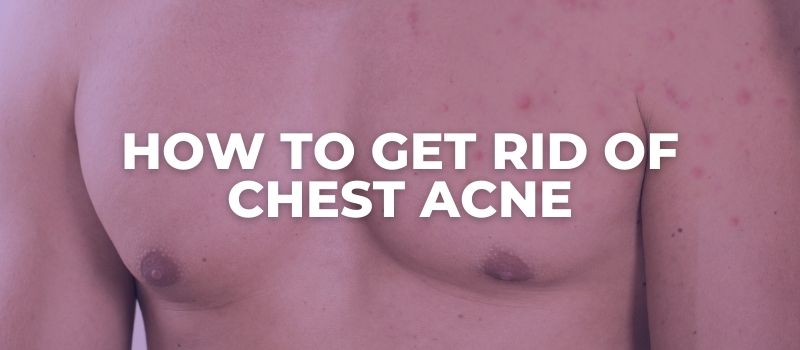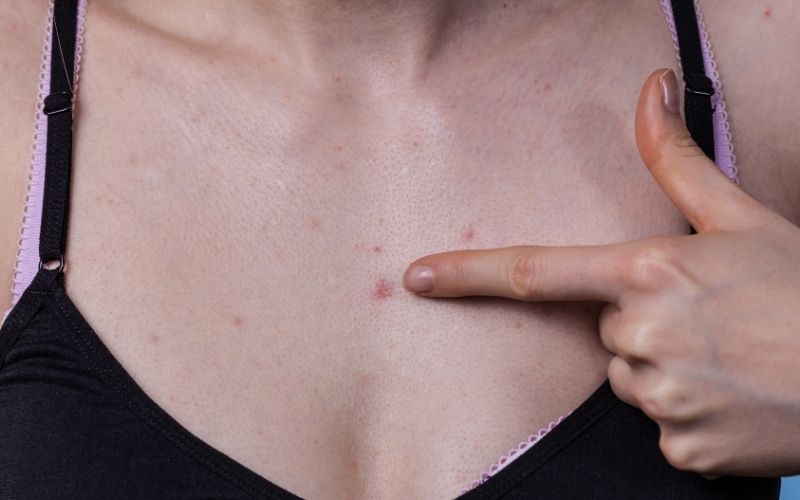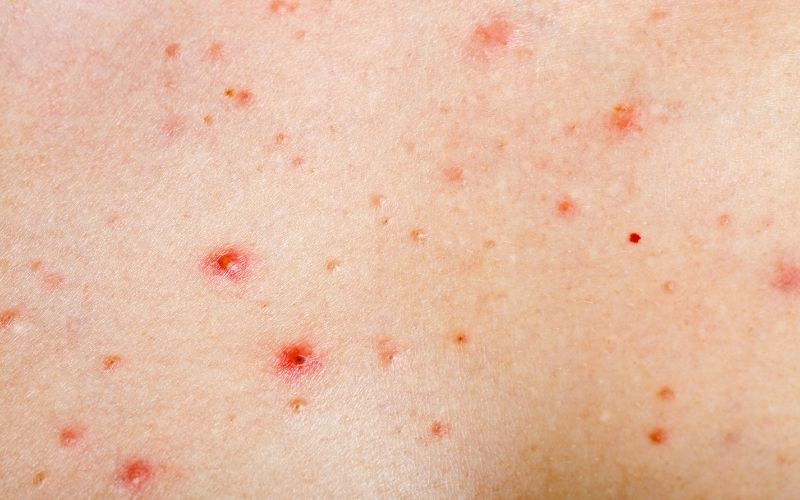Whether due to hormonal fluctuations, sweat, or tight clothing, chest blemishes can undermine confidence and lead to severe discomfort, especially during summer when we wear lighter and more revealing clothing.
However, although persistent, chest acne can be fought off with the right approach that includes minor changes in your body care routine and using the right skincare products.
Therefore, in this article, I will list effective strategies and suggestions on how to get rid of acne on chest, and maintain the smooth, clear, and healthy skin of your dreams.
TLDR: To get rid of chest acne, much like regular facial acne, you need to keep the area clean and apply topical treatments such as salicylic acid, benzoyl peroxide, and retinoids.

What Causes Chest Acne?

Here are a few common factors that cause chest acne:
Clogged Pores
Every acne type, no matter how mild and non-inflammatory, starts as a clogged pore.
Our pores get clogged when excess sebum gets stuck inside the pores instead of traveling to the skin’s surface, where it serves as a natural moisturizer and a mild UV protector.
This clog attracts a specific strain of bacteria that feed on it and proliferate, and when the bacteria overgrow, the immune system recognizes it as an intruder and sends its soldiers (white blood cells) to fight it.
This results in inflammation that appears as acne on the skin.
Therefore, to treat acne in any area of the face and body, you need to start by using products that will clear out the clogs responsible for causing this condition.
Hormones
Hormones can stimulate sebaceous activity, which means they can influence how much oil the sebaceous glands produce.
Dihydrotestosterone is a male hormone that can cause chest acne due to stimulating sebaceous overactivity, which results in excess oil production, clogged pores, and, subsequently, acne.
This hormone belongs to a male group of hormones known as androgens, which are present in both men and women.
However, androgen levels can become imbalanced due to various factors, including an inflammatory diet, prolonged stress, poor digestion, certain medications, etc.
When an imbalance occurs, this is when androgens can become overactive and start to cause issues such as inflammation in the system that will eventually show on the skin in the form of an inflammatory condition such as acne.
Fabric Softeners
Waxy substances found in fabric softeners and dryer sheets are designed to coat fabrics to make them feel softer and reduce static cling.
However, when clothes treated with these products come into contact with the skin, the waxy residue can transfer and adhere to the skin’s surface.
This can lead to clogged pores, trapping bacteria, and dead skin cells, which is a primary cause of chest acne and irritation.
Heavy Moisturizers
Heavy moisturizers, body lotions, and body oils often contain comedogenic ingredients, which are known to clog pores and disrupt the skin’s natural balance.
When applied, especially in areas prone to sweating, like the chest, these products can trap bacteria, dead skin cells, and sebum within the pores.
This accumulation creates an ideal environment for acne breakouts, leading to the development of chest acne.
Folliculitis
Folliculitis refers to a spectrum of skin conditions characterized by inflammation of the hair follicles.
While facial acne and its variants fall within the broader category of folliculitis, it is important to distinguish that they are not identical conditions.
The hallmark features of folliculitis include tender, red spots on the skin, often accompanied by a pustule at the surface, and the condition can cause mild to moderate itchiness.
Folliculitis is classified as either superficial or deep, depending on the extent of follicular involvement, and can occur on any part of the body with hair growth, such as the chest, back, buttocks, thighs, arms, and legs.
How To Treat Chest Acne?

Getting rid of chest acne may sound complicated, and the process can take a long time and requires patience and consistency.
However, the good news is that it’s not impossible, and if the right approach is taken, minimal effort can yield significant results.
Therefore, here are a few habits you should consider incorporating into your daily routine to help soothe and minimize the appearance of chest acne:
Apply Warm Compress
Applying a warm compress to the inflamed area will not only soothe the skin but soften the bumps and prep the skin for further treatment.
Wet a washcloth with warm but not too hot water and gently press the damp cloth over the area on your chest where an acne outbreak is occurring.
It’s best to hold the cloth pressed to the area for 3-5 minutes until the skin softens.
Exfoliate
Gentle exfoliating acids such as glycolic, mandelic, and salicylic acid can help reduce the severity of chest acne by dissolving the cellular gunk stuck inside the pores and soothing inflammation.
Therefore, try to incorporate at least one of these components, such as a cleanser, toner, or serum, into your daily body care routine to reduce inflammation, flatten pimples, and fade redness from the affected area.
On the other hand, avoid any type of physical exfoliation, such as loofahs, brushes, or scrubs, as abrasive components can rupture the bump, causing pus and bacteria to spread and affect the surrounding area.
Avoid Tight Clothing
Wearing tight clothing, especially during summer, can contribute to chest acne due to promoting excess sweating and follicle inflammation from constant rubbing.
This friction and trapped sweat create an ideal environment for bacteria to thrive, leading to clogged pores and inflamed hair follicles.
Opting for loose, breathable fabrics can significantly reduce these risks by allowing air to circulate more freely around the skin, helping to keep the area dry and reducing the chance of bacterial growth and inflammation.
Shower Regularly
This is not to say that you are not showering enough or that you aren’t clean; however, showering more frequently (especially during the summer) is recommended for those who are prone to body acne.
The chest is an exceptionally sweaty area for both men and women, and unfortunately, sweat can exacerbate body acne for many who are prone to this inflammatory skin condition.
Showering or simply rinsing with water at least once or twice daily is a good way to keep the area clean and dry.
Switch to Fragrance-Free Body Wash
Scented shower gels, while appealing for their pleasant aromas, often contain fragrances and essential oils that can irritate the skin, leading to inflammation and chest acne.
These ingredients disrupt the skin’s natural protective barrier, making it more susceptible to breakouts, as fragrance is a known skin irritant that can cause acne even in those not typically prone to this inflammatory condition.
Switching to a fragrance-free body wash can help mitigate these issues by reducing skin irritation and maintaining the integrity of the skin’s barrier, therefore improving the condition of chest acne.
Blot
If you can’t shower once or twice a day, try to keep the chest area clean and dry by using dry wipes to blot away excess sweat.
Avoid using wet wipes to blot, as they contain high alcohol and fragrance content, which can potentially irritate the skin and exacerbate inflammation.
Opting for dry wipes, kitchen rolls, or even toilet paper is preferred.
7 Best Products To Get Rid of Chest Acne
Getting rid of chest acne may take some time and will require changing your body care routine to treat the existing lesions, prevent new ones from forming, and fade the scars left by this inflammatory skin condition.
Here are the best products to get rid of chest acne:
CeraVe – Acne Foaming Cream Cleanser 4% Benzoyl Peroxide

The CeraVe Acne Foaming Cream Cleanser 4% Benzoyl Peroxide is a gentle cream containing a high concentration of benzoyl peroxide, which helps soothe moderate to severe acne on the face and body.
Benzoyl peroxide is an effective antibacterial agent that infuses the pores with oxygen to destroy the airless environment bacteria prefer to live in.
Thus, it reduces the pathogen’s proliferation and soothes the inflammation it has caused.
However, while efficiently eliminating the overgrowth of bacteria inside the pores, benzoyl peroxide can be excessively drying and irritating for the skin; therefore, it should be used cautiously and no more than 2-3 times a week.
La Roche Posay – Effaclar Medicated Gel Cleanser

The La Roche-Posay Effaclar Medicated Gel Cleanser is another gel cleanser you can use to get rid of chest acne.
It contains salicylic acid, a gentle exfoliating acid that cuts through superficial skin oil and cleanses the pores from the inside out.
Due to its gentle formula and low concentration of the active ingredient, the Effaclar Medicated Gel Cleanser can be used as a daily body wash to soothe inflammation, clear out cellular gunk stuck inside the pores, and soothe active acne lesions in any area of the body.
Galderma – Differin Gel

Differin Gel is an over-the-counter ointment containing the active ingredient adapalene, a synthetic retinoid effective in treating inflammatory and non-inflammatory acne, such as blackheads, pustules, papules, and cysts.
You should start using Differin Gel by applying it to clean, dry skin no more than two times a week and slowly (over a few weeks) build up to more frequent usage.
Once you start using retinoids, you should expect a mild to moderate purge, and you should always protect the area with sunscreen in the morning.
Paula’s Choice – Acne Body Spray

The Paula’s Choice Body Spray is an effective acne treatment containing salicylic acid and antioxidants to nourish the skin and soothe the redness surrounding the affected area.
The product comes in a convenient spray bottle and can be used on any body part with inflammatory or cystic acne.
Avoid spraying this product directly onto your face because you may inhale its contents.
The Ordinary – Glycolic Acid 7% Toning Solution

The Ordinary’s Glycolic Acid 7% Toning Solution is an affordable and effective option to treat active acne and post-inflammatory hyperpigmentation, which usually appears in the affected area after acne has healed.
The toner has a lightweight, water-like consistency that absorbs quickly into the skin without leaving a greasy layer behind.
However, due to its potent exfoliating acid content, it should be used no more than 2-3 times a week, and it should be followed up with sunscreen in the morning, especially if the treated area is exposed.
Versed – Weekend Glow Brightening Solution

The Versed Weekend Glow Daily Brightening Solution is a good option for clearing acne scars on both light and dark skin tones.
It contains skin-lightening agents such as glycolic acid, lactic acid, kojic acid, and niacinamide to even out the skin tone and fade hyperpigmentation.
Additionally, the formula also contains azelaic acid, which is effective at improving post-inflammatory redness or red spots left from acne, which are more prominent in light skin tones.
Tretinoin
Tretinoin is a prescription-strength form of vitamin A that has been widely recognized for its ability to promote rapid cell turnover and prevent the clogging of pores, making it an effective treatment for acne on the chest and other parts of the body.
Its action helps to reduce inflammation, clear acne breakouts, and improve the overall texture of the skin.
Studies and dermatological advice suggest that tretinoin can be particularly beneficial in managing body acne by targeting the root causes, including factors that lead to excessive oil production and clogged pores.
However, although using tretinoin on chest acne can yield fantastic results in minimizing the severity of the lesions, this product is known for causing initial side effects, such as dryness, flaking, redness, irritation, and purging, and should be used with caution, and followed by the application of high SPF, especially if the treated area is exposed to the sun.
Chest Acne Related Questions:
Below, I will answer a couple of the most frequently asked questions regarding chest acne:
How To Get Rid Of Chest Acne Scars?
Chest acne scars usually appear as dark, brownish, or purple spots that can be treated with the use of exfoliating acids and lightening agents such as niacinamide, kojic acid, azelaic acid, and vitamin C.
How To Prevent Chest Acne?
Avoiding fabric softeners, wearing loose clothing during the summer months, blotting excess sweat, keeping the area dry, applying a warm compress to soften the skin, regular exfoliation with gentle acids, antibacterial agents such as benzoyl peroxide, and frequent showering are all efficient ways to prevent chest acne.
How to Get Rid of Chest Blackheads?
To get rid of chest blackheads, use a gentle exfoliating toner or a cleanser containing salicylic, mandelic, or glycolic acid, as these can help remove dead skin cells, unclog pores, and promote clear, smooth skin.

My name is Simone and I am a certified skin specialist. I created this website to teach my readers how to take great care of their skin and I also like to occasionally share my honest opinions on skincare products I’ve tried. You can learn more about me here.
